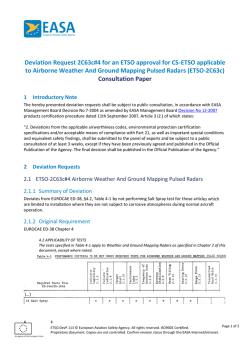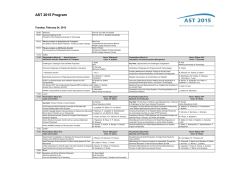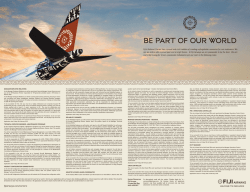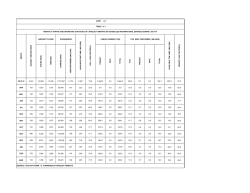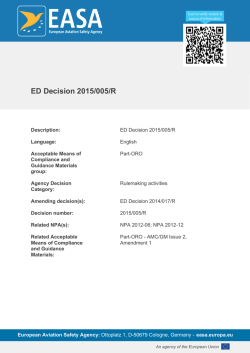
Edition January 2015 Final pdf
Avionics requirements for civil aircraft Edition January 2015 Civil aircraft – Communications requirements Domain Programme Area VHF Com 8.33 KHZ Equipment Requirement The probability of the loss of voice communication is better than or equal to remote. Depending of the size of the aircraft and the kind of operation, this could mean that only one set of 8.33kHz COM is required. Manufacturers of radios intended to operate in the VHF band, or their authorised representatives established in the Union, shall ensure that from 17 November 2013 all radios placed on the market, are 8,33 kHz channel spacing capable. VHF Com Immunity from FM radio broadcasts Controller-Pilot Data Link Communications (CPDLC) ATN/VDL Mode 2 ECAC Airspace Requirement Mandatory carriage above FL195 from 15 March 2007. Below FL195: the European Commission published the new voice channels spacing implementing rule in the Official Journal of the EU on the 16 November 2012 as Regulation (EU) No 1079/2012 All VHF Comm. equipment 3rd VHF Digital Radio, also either: Communications Management Unit (CMU) and Multifunction Control Display Unit (MCDU), or Air Traffic Service Unit (ATSU) and Dedicated Control and Display Unit (DCDU) or Integrated solution (e.g. Boeing FANS2) or Electronic Flight Bag solution (TBD) JAA / EASA Airworthiness or Operational Requirement For guidance on airworthiness and operational aspects se JAA TGL 7 Rev 1 See also EASA NPA 2013-06 Rest of EU: Feb 2015 Below FL195: Europe has agreed to extend the use of 8.33 kHz radios in several phases: Phase 2 (2014), a small number of control sectors in the most frequency congested areas in which most aircraft are already 8.33 kHz capable will require 8.33 kHz radio equipage. Phase 3 (by 31st Dec. 2018), aims for full deployment in all European airspace, however European States can propose to delay deployment in areas that have a limited network impact. For guidance see JAA TGL16 SES Data Link Services Implementing Rule - EC Reg. No. 29/2009 for above FL 285 Core Europe (LINK Region): Feb 2013 Remarks EASA Special Condition on ATN B1 Data Link installation. Attention: Possible amendments to regulation 29/2009 may follow Some states may have exempted from the requirement, Airframe Dates Forward Fit : Jan 2011 Retro Fit : Jan 2015 ** Additional information Link2000 + Programme Website Civil aircraft – Navigation requirements Domain Programme Area Equipment Requirement ILS ILS receiver MLS MLS receiver B-RNAV RNAV systems capable of + 5 NM accuracy P-RNAV RNAV systems capable of + 1 NM accuracy RVSM ICAO Min. Aircraft System Performance Standard (MASPS) RNP APCH (to LNAV) APV/Baro VNAV (RNP APCH to LNAV/VNAV) APV SBAS (RNP APCH to LPV) RNP AR APCH Requirements for SBAS receivers are contained in ICAO annex 10 Volume 1. Also see specification RTCA DO 229C and FAA TSO C145/146A ECAC Airspace Requirement JAA / EASA Airworthiness or Operational Requirement EU OPS 1.865 Mandatory all en - route airspace. See EASA AMC 20–5 and FAA 90-96 See EASA AMC 20–5, FAA 90-96 and JAA TGL10 -Revision 1. OPS approval required to fly PRNAV Mandated From FL 290 to FL410 EC 965/2012, EASA Part SPA and CSACNS Deployment status and plan available on the PBN Approach map Deployment status and plan available on the PBN Approach map See AMC 20-27 Deployment status and plans available on the PBN Approach map Under consideration at selected airports Deployment status and See AMC 20-27 See also FAA documents AC20-138, AC20-130A AC20-129 See AMC 20-28. See AMC 20-26 Remarks Terminal aid available at most airports. Terminal aid to be made available at London Heathrow. Under consideration at other airports For ECAC airspace the primary sources of navigation information are VOR/DME, DME/DME and GPS. The availability and continuity of VOR and DME coverage have been calculated for most of Europe and they are considered to be capable of meeting the requirements of the en-route phase of operations. Currently being introduced (whilst no ECAC-wide mandate for the carriage of P-RNAV is foreseen, some States may require P-RNAV certification for IFR operations in notified terminal airspace). See additional details at: www.eurocontrol.int/eurrma and http://www.eurocontrol.int/a rticles/rvsm-state-aircraft APV is to be introduced as a replacement for NPA and therefore a means to reduce CFIT incidents by providing aircraft a stabilised approach. SBAS supports RNAV Approach operations to LPV minima. GBAS/GLS 4D RNAV GBAS equipment is contained in aircraft multimode receiver (MMR). GBAS performance specification is contained in RTCA DO 253c LAAS receiver MOPS. plans available on the PBN Approach map In operation at selected airports (Cat I operations). Cat II/III operations in validation. Deployment status and plans available at www.flygls.net Under consideration Operational approval not required for Cat I (ILS look-alike) and under development for Cat II/III. GBAS SARPS for Cat 1 became applicable in Nov 2001 (refer to ICAO SARPS annex 10 volume 1) GBAS SARPS for Cat II/III published as baseline development standards. Long term objective Civil aircraft – Surveillance requirements Domain Programme Area Emergency Locator / ELT Equipment Requirement MANDATED 1/1/2002 ECAC Airspace Requirement Consult National A.I.P JAA /EASA Airworthiness or Operational Requirement See EU OPS 1 Subpart L (1.820) Upcoming requirement EASA NPA 2013-26: ICAO SARPS Annex 6 Part 1, para 6.17 See also EU OPS 1 subpart K (1.820) 1) Cockpit Voice Recorder: additional requirement ULD (Underwater Location Device) after 1 January 2020: minimum underwater transmission time of 90 days. 2) Provision (flight over water with an Aeroplane operated for commercial air transport) to require that aeroplanes with an MCTOM of over 27 000 kg and first issued with an individual CofA on or after 1 January 2005 are, no later than 2019, equipped with an 8.8 kHz ULD (ULD with a very long detection range). SSR Mode A/C (Surveillance with Altitude reporting) SSR Mode S Elementary Surveillance (ELS) ICAO Annex 10, Volume IV, Chapter 2 “Basic Functionality” required: Automatic reporting of Aircraft Identity Transponder capability report Altitude reporting in 25 ft intervals Flight status SI Code capability Mandated Commission Implementing Rule (IR) EU1207/2011 (laying down requirements for the performance and the interoperability of surveillance for the single European sky), as amended by EU1028/2014 Specifies the airborne equipage requirements for Mode S ELS. However, existing The EASA Certification Specification for Airborne Communications, Navigation and Surveillance (CS-ACNS), published December 2013, provides the avionics certification documentation in line with Commission Implementing Rule EU1207/2011. (See http://easa.europa.eu/agencymeasures/docs/agencydecisions/2013/2013-031R/Annex%20I%20to%20ED%20 Decision%202013-031-R.pdf ). The EASA Certification Specification for Airborne Communications, Navigation and Surveillance (CS-ACNS), published December 2013, provides the avionics certification documentation in line with Commission Implementing Rule EU1207/2011. (See http://easa.europa.eu/agencymeasures/docs/agencydecisions/2013/2013-031R/Annex%20I%20to%20ED%20 Decision%202013-031-R.pdf ). Remarks ICAO Worldwide aircraft requirement. All aircraft with a C of A after 1/1/2002 shall be equipped with an automatic ELT capable of transmitting on 121.5MHz and 406MHz.Aeroplanes with a C of A before 1/1/2002 must have any type of ELT capable of transmitting on 121.5MHz and 406MHz. An Operator shall ensure that all ELTs that are capable of transmitting on 406Mhz shall be coded in accordance of ICAO Annex 10 and registered with the national agency responsible for initiating a search & rescue service. The requirement within each National Airspace can vary therefore refer to National AIC’s and AIP’s Commission Implementing Rule EU1207/2011, as amended by EU1028/2014, specifies overall airborne equipage deadlines, however, the requirement within each State's jurisdiction can vary. Therefore refer to National AICs and AIPs. See CS-ACNS State mandates that stipulate equipage compliance earlier than the dates specified in this rule remain applicable. It should also be noted that some States, e.g. DE and NL have published mandates requiring aircraft flying VFR to be compliant with Mode S ELS. Mode S ELS is already in operational use within MUAC airspace, and the designated airspace of a number of States including DE, NL, FR, CH, AT, IT, CZ, HU and RO In some States the requirement is also applicable for flights conducted as VFR. ELS operations will extend to all of the airspace defined in Article 1(3) of Regulation (EC) No 551/2004 of the European Parliament and of the Council, by not later than 02 January 2020. Note that local requirements remain in force and are supplemented by EU1207/2011. SSR Mode S Enhanced Surveillance (EHS) See EASA CSACNS Commission Implementing Rule (IR) EU1207/2011 (laying down requirements for the performance and the interoperability of surveillance for the single European sky), as amended by EU1028/2014 specifies the airborne equipage requirements for Mode S ELS. However, existing State mandates that stipulate equipage compliance earlier than the dates specified in this rule remain applicable. It should also be noted that some States, e.g DE and NL have published mandates requiring aircraft flying VFR to be compliant with Mode S ELS. Commission Implementing Rule (IR) EU1207/2011 (laying down requirements for the performance and the interoperability of surveillance for the The EASA Certification Specification for Airborne Communications, Navigation and Surveillance (CS-ACNS), published December 2013, provides the avionics certification documentation in line with Commission Implementing Rule EU1207/2011. (See http://easa.europa.eu/agencymeasures/docs/agencydecisions/2013/2013-031R/Annex%20I%20to%20ED%20 Decision%202013-031-R.pdf ). Commission Implementing Rule (IR) EU1207/2011 amended by EU1028/2014 specifies overall airborne equipage deadlines, however, as detailed in two columns to the left, the current requirement within each State's jurisdiction can vary. Therefore refer to National AICs and AIPs The requirement is likely to be expanded into other portions of ECAC airspace. Thus National AICs and AIPs should be consulted. Note that local requirements remain in force and are supplemented by EU1207/2011 amended by EU1028/201 single European sky), as amended by EU1028/2014, specifies the airborne equipage requirements for Mode S EHS. However, existing State mandates that stipulate equipage compliance earlier than the dates specified in this rule remain applicable. ADS -B Automatic Dependant Surveillance Broadcast ADS-B Out Transmit System: EASA ETSO / C166b EUROCAE ED102A / RTCA DO-260B ICAO Annex 10 Doc. 9871 Ed.2 ADS-B Out Horizontal Position Source: EASA ETSO-129a (plus specific CS-ACNS qualifications). EHS is currently mandated currently in designated airspace of France, Germany, the United Kingdom and the Czech Republic. EHS is also mandated above FL 245 in the airspace of Belgium and the Netherlands (within airspace delegate to MUAC). If an exemption against the carriage and operation of Mode S EHS airborne equipment is required, the operator of the aircraft shall apply to the appropriate National Aviation Authorities. Operators should note that a separate exemption will be required from each of the Mode S implementing States within which flights are planned to take place. Commission Implementing Rule (IR) (EU) No 1207/2011 (laying down requirements for the performance and the interoperability of surveillance for the single European sky) amended by EU1028/2014 specifies the airborne equipage requirements for “ADS-B Out”. The EASA Certification Specification for Airborne Communications, Navigation and Surveillance (CS-ACNS), published December 2013, provides the avionics certification documentation in line with Commission Implementing Rule EU1207/2011. (See http://easa.europa.eu/agencymeasures/docs/agencydecisions/2013/2013-031R/Annex%20I%20to%20ED%20 Decision%202013-031-R.pdf ). For more details: consult (IR) (EU) No 1207/2011 , EU1028/2014 Standards and implementation timescales are being co-ordinated with FAA, Air services Australia and NAV CANADA. Ground implementation commitment from some 20 European Air Navigation Service Providers (through ADSB/WAM deployments). Civil aircraft – Safety Assurance requirements Domain Programme Area ACAS ll Equipment Requirement TCAS ll Software Version 7.0 or 7.1 (adjacent column) ICAO Annex 10 vol.4, PANS OPS Doc 8168. PANS ATM Doc 4444. ICAO Doc 9863 (ACAS Manual) ICAO Annex 6, Operation of Aircraft, Part 1 – International Commercial Air Transport – Aeroplanes. European Commission Implementing Rule 1332/2011 ECAC Airspace Requirement European Union Airspace: TCAS II version 7.1: - all (civil) aircraft with a maximum certified take-off mass exceeding 5,700 kg or authorised to carry more 19 passengers from 1 March 2012; - with the exception of aircraft with an individual certificate of airworthiness issued before 1 March 2012 that must be equipped as of 1 December 2015; JAA/EASA Airworthiness or Operational Requirement EU-OPS 1 Subpart K (1.668) European Commission Implementing Rule 1332/2011 For certification JAA TGL 8 Revision 2 EGPWS/TAWS ICAO ANNEX 6 part 1: Operation of Aircraft, 6.15; Part II: Operation of Aircraft, 6.9. MEL for TCAS II throughout Europe is Class A - 10 days (excluding the day of discovery). MEL requirements concerning partial failures are listed in the TGL 26. For pilot training and operational procedures ICAO PANS-OPS Doc 8168, ICAO Doc 9863 and JAA TGL11. Guidance Document for MEL Policy JAA TGL 26 Some States may have different requirements. E.g. in German airspace, the time period during which TCAS II may be inoperative is reduced to 3 days (refer to German AIP GEN 1.5 para 5). This applies to all aircraft. Some States temporarily waived the TCAS II version 7.1 equipage requirement by NOTAM (check applicable NOTMAs) An operator shall not operate a turbine powered aeroplane having a maximum certificated take-off mass in excess of 5 700 kg or a maximum approved passenger seating configuration of more than nine unless it is equipped with a ground proximity warning system that includes a predictive terrain hazard warning function (terrain Note: ICAO worldwide mandate - Aircraft not referred above but which will be equipped on a voluntary basis with ACAS II, must be equipped with version 7.1. ECAC (outside EU airspace): All civil fixed-wing turbineengined aircraft with a maximum take-off mass over 5,700 kg, or capable of carrying more than 19 passengers, must be equipped with TCAS II version 7.0. See EASA CSACNS Remarks For further guidance on EGWPS airworthiness requirements: refer to your state regulator. Flight Data Monitoring awareness and warning system — TAWS). Awaiting EASA adoption Proposal is for aircraft > 27,000kg to be equipped with a suitable electronic flight data recorder or quick access recorder where flight data can be regularly replayed for purposes of crew monitoring. Avionics requirements for State aircraft Edition November 2014 State aircraft – Communications requirements Capability 25 kHz VHF Voice 8.33 kHz VHF Voice Civil Requirements 2 sets of VHF Transceivers with 25kHz channel spacing 2 Sets of VHF Transceivers with 8,33 KHZ channel spacing Mandate Status State Aircraft equivalent equipage Mandated for non8.33kHz area, e.g. below FL 245 Mandatory carriage above FL195 from 15 March 2007. Carriage applicable also below FL195 from 17 November 2012. It applies to all State aircraft with transition arrangements for technical and procurement constraints including handling on VHF 25 kHz or UHF by ANSPs 2 sets of 8.33 kHz VHF radios are mandated by JAR-OPS, JAA TGL7 for civil aircraft. It remains to be defined a similar backup policy for State aircraft when equipped with one 8.33 kHz VHF radio and UHF. EC regulation 1079/2012 (Article 9) contains arrangements for State aircraft Above FL 195 non-transport type State aircraft when justified by procurement constraints are to equip by 31 December 2015 at the latest All State aircraft entering into service (or suffering major mid life upgrades) after 01 January 2014 to be equipped (Forward Fit) Retrofit all State aircraft by 31 December 2018 Transition Arrangements are possible due to technical, budgetary or procurement constraints with communication to the Commission by 30 June 2018 and equipage by 31 December 2020 at the latest Exempted: All State aircraft that go out of service by 31 December 2025 ATS providers are to accommodate non-equipped State Aircraft on UHF or VHF 25 kHz, provided safety ensured. Publication in national aeronautical information publication (AIP) of applicable procedures is also required. VHF FM Immunity Controller-Pilot Data Link Communications (CPDLC) ATN/VDL Mode 2 ILS and VOR receivers to be protected against interference from VHF broadcast. FM immune VHF equipment is to be used CPDLC application over ATN/VDL Mode 2 (or other communication protocols). See Mandated for enroute and airports as specified in national AIPs Exemptions for State a/c may still be negotiated on a bilateral basis. See national AIPs. EC regulation 29/2009 requires implementation by ATS providers of data link services for The EC regulation 29/2009 includes provisions on State aircraft. Member States which decide to equip new transport type State aircraft entering into equipage details above (civil aircraft) above FL 285 In Core Europe (LINK Region): February 2013; Rest of EU: February 2015. service from 01 January 2014 with data link capability relying upon standards which are not specific to military operational requirements, shall ensure that those aircraft have the capability to operate the data link services defined in the Regulation (with ATN/VDL Mode 2 data link or other communications protocol). Technical guidance: EASA Special Condition on ATN B1 Data Link installation. Attention: Possible amendments to regulation 29/2009 may follow State aircraft – Navigation requirements Capability ILS MLS B-RNAV Civil Requirements ILS receiver MLS receiver (EU OPS 1.865) RNAV systems capable of + - 5 NM accuracy Mandate Status Mandatory all en - route airspace. See EASA AMC 20– 5 and FAA 90-96) P-RNAV State aircraft are exempted from the B-RNAV mandatory requirement. Within TMAs, non BRNAV State aircraft should be routed via non-RNAV-based SIDs and STARs. For en route, State aircraft should be routed via VOR/DME or TACAN-defined ATS routes or via conventional navigation aids. See national AIPs. Currently being introduced (whilst no ECAC-wide mandate for the carriage of P-RNAV is foreseen, some States may require P-RNAV certification for IFR operations in notified terminal airspace). RNAV systems capable of + - 1 NM accuracy (See EASA AMC 20–5, FAA 90-96 and JAA TGL10 Revision 1 OPS approval required to fly PRNAV) RVSM ICAO Min. Aircraft System Performance Standard (MASPS) The RVSM MASPS include: (1) Two independent, crosscoupled altitude measurement systems; (2) One automatic altitude control system (±65'); (3) One altitude alert system (±300'/±50'); (4) One SSR altitude reporting transponder (5) RVSM compliant avionics configuration. (See JAA TGL 6 Revision1 and EU OPS 1 Subpart L (1.872) State Aircraft equivalent equipage Available as part of Multi-Mode Receiver (MMR) Available as part of Multi-Mode Receiver (MMR) For ECAC airspace the primary sources of navigation information are VOR/DME, DME/DME and GPS. The availability and continuity of VOR and DME coverage have been calculated for most of Europe and they are considered to be capable of meeting the requirements of the en-route phase of operations. Mandated From FL 290 to FL410 For certain TMAs for aircraft that are not approved for P-RNAV operations conventional procedures may continue to be available as stated in national AIPs State aircraft can be accommodated in RVSM airspace: Military aircraft operating as GAT which are non MASPS RVSM compliant are allowed in RVSM airspace but are subject to 2000ft vertical separation from all other aircraft. However, States are requested to adapt their State aircraft for RVSM approval, to the extent possible, and especially those aircraft used for General Air Traffic (GAT). There is no exemption for State aircraft to operate as GAT within RVSM airspace (FL 290 to FL 410) with a 1000 ft vertical separation minimum without an RVSM approval. The absence of such approval does not mean that State aircraft cannot access RVSMdesignated airspace, but it does require a separation of 2000 ft to be observed. Non-approved State aircraft operating within RVSM airspace with a 2000 ft vertical separation requires the submission of a flight plan with “M” in field 10 and “STS/NONRVSM” in field 18. On September 2014 the Military ATM Board endorsed the EUROCONTROL Guidance Material for the Certification and Operation of State Aircraft in European RVSM Airspace V2.0. See additional details at: www.eurocontrol.int/eurrma and http://www.eurocontrol.int/articles /civil-military-navigationinteroperability RNP APCH (to LNAV) Deployment status and plan available on the PBN Approach map (AMC 20-27). Specific applicability to State aircraft not defined. May be considered in the context of PBN. APV/Baro VNAV (RNP APCH to LNAV/VNAV) Deployment status and plan available on the PBN Approach map ( AMC 20-27, also FAA documents AC20-138, AC20-130A and AC20129 APV is to be introduced as a replacement for NPA and therefore a means to reduce CFIT incidents by providing aircraft a stabilised approach. Specific applicability to State aircraft not defined. May be considered in the context of PBN. SBAS supports RNAV Approach operations to LPV minima. Specific applicability to State aircraft not defined. May be considered in the context of PBN. SBAS APV (RNP APCH to LPV) RNP AR APCH GBAS/GLS 4D RNAV Requirements for SBAS receivers are contained in ICAO annex 10 Volume 1 Also see specification RTCA DO 229C and FAA TSO C145/146A. Under consideration at selected airport. Deployment status and plan available on the PBN Approach map. (See AMC 20-26) GBAS equipment is contained in aircraft multi-mode receiver (MMR). GBAS performance specification is contained in RTCA DO 253c LAAS receiver MOPS. In operation at selected airports (Cat I operations). Cat II/III operations in validation. Deployment status and plans available at www.flygls.net. Under consideration Deployment status and plan available on the PBN Approach map. Specific applicability to State aircraft not defined. May be considered in the context of PBN. GBAS SARPS for Cat I became applicable in Nov 2001 (refer to ICAO SARPS annex 10 volume 1). GBAS SARPS for Cat II/III published as baseline development standards. Specific applicability to State aircraft not defined. May be considered in the context of PBN taking due account of available MMR capability. Long term objective. Specific applicability to State aircraft not defined. State aircraft – Surveillance requirements Capability SSR Mode A+C SSR Mode S Elementary Surveillance (ELS) Civil Requirements Mode A/C airborne transponder “Basic Functionality” required: • Automatic reporting of Aircraft Identity • Transponder capability report • Altitude reporting in 25 ft intervals • Flight status • SI Code capability See CS-ACNS Mandate Status Mandated for IFR/GAT, and for VFR/OAT in 'designated airspace' However, note Mode S requirement below Commission Implementing Rule (IR) (EU) No 1207/2011 (laying down requirements for the performance and the interoperability of surveillance for the single European sky) amended by EU1028/2014 specifies the airborne equipage requirements for Mode S ELS in State aircraft.. For State aircraft that can’t be equipped in due time the IR describes transitional arrangements and mandates ANSPs to accommodate Non–equipped state aircraft within the safety limits of their system. These limits have to be justified annually to their Member State. The EASA Certification Specification for Airborne Communications, Navigation and Surveillance (CS-ACNS), published December 2013, provides the avionics certification documentation in line with Commission Implementing Rule EU1207/2011. (See http://easa.europa.eu/agencymeasures/docs/agencydecisions/2013/2013-031R/Annex%20I%20to%20ED%20Decisi on%202013-031-R.pdf ). State Aircraft equivalent equipage (IR) (EU) No 1207/2011 amended by EU1028/2014 specifies overall airborne equipage deadlines, however, the requirement within each State's jurisdiction can vary. Therefore refer to National AICs and AIPs. Mode S ELS is already in operational use within MUAC airspace, and the designated airspace of a number of States including DE, NL, and FR., CH, AT, IT, CZ, HU, and RO In some States the requirement is also applicable for flights conducted as VFR. ELS operations will extend to all of the airspace defined in Article 1(3) of Regulation (EC) No 551/2004 of the European Parliament and of the Council, by not later than 02 January 2020. Non-compliant State aircraft: All State aircraft not yet compliant with Mode S ELS requirements need a dispensation for flights in ELS and EHS notified airspace. For more details: consult (IR) (EU) No EU 1207/2011, EU1028/2014 and www.eurocontrol.int/mil SSR Mode S Enhanced Surveillance (EHS) Commission Implementing Rule (IR) EU 1207/2011 (laying down requirements for the performance and the interoperability of surveillance for the single European sky) amended by EU1028/2014 specifies the airborne equipage requirements for Mode S EHS in transport type State aircraft. For State aircraft that can’t be equipped in due time the IR describes transitional arrangements and mandates ANSPs to accommodate Non–equipped state aircraft within the safety limits of their system. These limits have to be justified annually to their Member State EHS is currently mandated currently in designated airspace of DE, FR and GB EHS equipment is only required for "transport type" State aircraft. "Transport type" State aircraft are liable for EHS equipage when flying IFR/GAT in EHS designated airspace, all DAPs are available, MTOM is 5700 kg or more and maximum cruising true airspeed is in excess of 250 kts. Non-compliant State aircraft: Transport-type State aircraft assessed to be EHS capable but not yet compliant with EHS requirements need a dispensation for flights in EHS notified airspace. Transport-type State aircraft Also mandated above FL 245 in the airspace of BE and the NL (within airspace delegated to MUAC). The EASA Certification Specification for Airborne Communications, Navigation and Surveillance (CS-ACNS), published December 2013, provides the avionics certification documentation in line with Commission Implementing Rule EU1207/2011. assessed to be non-EHS capable do NOT need a dispensation for flights in EHS notified airspace. They must as a minimum however, be compliant with Mode S ELS requirements. For more details: consult (IR) (EU) No 1207/2011, EU1028/2014 and www.eurocontrol.int/mil (See http://easa.europa.eu/agencymeasures/docs/agencydecisions/2013/2013-031R/Annex%20I%20to%20ED%20Decisi on%202013-031-R.pdf ). ADS-B ADS-B Out Transmit System: EASA ETSO / C166b EUROCAE ED102A / RTCA DO260B Commission Implementing Rule (IR) (EU) No 1207/2011 (laying down requirements for the performance and the interoperability of surveillance for the single European sky) amended by EU1028/2014 specifies the airborne equipage requirements for “ADS-B Out”. in transport type State aircraft ADS-B Out Horizontal Position Source: The EASA Certification Specification for Airborne Communications, Navigation and Surveillance (CS-ACNS), published December 2013, provides the avionics certification documentation in line with Commission Implementing Rule EU1207/2011. EASA ETSO / C129a (plus specific CS-ACNS qualifications). (See http://easa.europa.eu/agencymeasures/docs/agencydecisions/2013/2013-031R/Annex%20I%20to%20ED%20Decisi on%202013-031-R.pdf ). ICAO Annex 10 Doc. 9871 Ed.2 For more details: consult (IR) (EU) No 1207/2011 , EU1028/2014 and www.eurocontrol.int/mil EASA Certification Specification for Airborne Communications, Navigation and Surveillance (CS-ACNS), published December 2013, providing the avionics certification documentation in line with regulation EU. Following the standard EASA NPA consultation process, it is expected to include requirements and acceptable means of compliance for Mode A/C only surveillance. The CS-ACNS will be compliant with Commission Implementing Rule (IR) EU No 1207/2011. amended by EU1028/2014 EASA AMC 20-24 remains applicable for initial implementations of “ADS-B Out” in a non-radar environment. State aircraft – Safety Assurance requirements Capability ACAS II Civil Requirements European Union Airspace: TCAS II version 7.1: - all (civil) aircraft with a maximum certified take-off mass exceeding 5,700 kg or authorised to carry more 19 passengers from 1 March 2012; Mandate Status Mandated for EUR Region (including FIR Canarias) by ICAO European Commission Implementing Rule 1332/2011 in EU airspace - with the exception of aircraft with an individual certificate of airworthiness issued before 1 March 2012 that must be equipped as of 1 December 2015; State Aircraft equivalent equipage ACAS mandate applies only to civil aircraft. Military authorities voluntarily committed to equip transport-type aircraft. In Germany, carriage and operation of ACAS II (i.e. version 7.0 or 7.1) by military transport aircraft is mandatory, see AIC IFR 13 20 MAR 03. Regulation 1332/2011 of 16/12/2011 mandated TCAS version 7.1 making reference to EASA Basic Regulation (216/2008) in respect to its applicability where military aircraft are excluded. The adoption of TCAS version 7.1 for transport type State aircraft may not seen as mandatory, in regulatory terms, but it is strongly encouraged for safety reasons. For more details consult: http://www.eurocontrol.int/articles/acaspolicy - Aircraft not referred above but which will be equipped on a voluntary basis with ACAS II, must be equipped with version 7.1. http://www.eurocontrol.int/dossiers/acasii ECAC (outside EU airspace): All civil fixed-wing turbineengined aircraft with a maximum take-off mass over 5,700 kg, or capable of carrying more than 19 passengers, must be equipped with TCAS II version 7.0. Enhanced Ground Proximity Warning System (EGPWS) / Terrain Awareness Warning system (TAWS) Applicable to aircraft with: (1) MCTM>5700kg or a more than 30seats and a C of A issued after 1/1/2001; (2) same MTCM and if 9 seats or more and C of A issued after 1/1/2004; (3) same MCTM and 9 seats or more and already equipped with GPWS - no TAWS required Mandated from JAN 2003 Note: If MCTM>15000kg or passengers >30 the date is 01JAN 2005 and if MCTM>5700kg or passengers > 9 the date is 01JAN 2007 Applicability to State a/c not defined. This is not an ATM/CNS Requirement as stated in ICAO Annex 6 Part 1. Paras 6.15.5 to 6.15.7
© Copyright 2025
